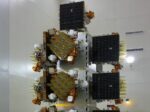Amid escalating cross-strait tensions and growing concerns over Chinese military assertiveness, Taiwan has launched a US$1.44 billion initiative to establish itself as a regional hub for unmanned aerial systems (UAS). The program aims to fortify Taiwan’s asymmetric defense posture by accelerating development and mass production of indigenous drones for reconnaissance, strike missions, and electronic warfare.
Strategic Context: Drones as Asymmetric Force Multipliers
Taiwan’s investment comes at a time when the People’s Liberation Army (PLA) is expanding its UAV capabilities across ISR (intelligence, surveillance, reconnaissance), loitering munition platforms, and swarming tactics. In response, Taipei is prioritizing unmanned systems as cost-effective tools to offset China’s numerical superiority.
The Ministry of National Defense (MND) has explicitly stated that drones—ranging from tactical FPVs to long-range UCAVs—are integral to Taiwan’s “asymmetric warfare” strategy. This doctrine emphasizes mobility, survivability, and precision strike over conventional force-on-force parity.
In recent years, PLA drones have routinely operated near Taiwan’s Air Defense Identification Zone (ADIZ), including flights by the BZK-005 and TB001 UAVs. Taiwan views these incursions not only as reconnaissance but also as rehearsals for decapitation or blockade scenarios. Indigenous counter-UAS capabilities are thus being developed in parallel.
Program Overview: NT$46 Billion for Domestic Drone Ecosystem
The National Chung-Shan Institute of Science & Technology (NCSIST), Taiwan’s primary defense R&D agency under the MND umbrella, is spearheading the five-year program with a budget of NT$46 billion (~US$1.44 billion). The initiative covers R&D acceleration, platform diversification across fixed-wing/rotary/fixed-wing hybrid types, supply chain localization, and production scaling.
- Timeline: The program runs from 2024 through 2028.
- Scope: At least six drone types will be mass-produced; over a dozen more are in various stages of prototyping or testing.
- Industrial Base: Over 40 Taiwanese companies are involved—including GEOSAT Aerospace & Technology Inc., Thunder Tiger Group (TTG), DronesVision Inc., Tron Future Tech—and several universities contributing AI/avionics research.
- Diversification: Platforms span ISR drones like Albatross II; loitering munitions such as Chien Hsiang; micro FPVs; rotary-wing quadcopters; and larger MALE-class UCAVs under development.
Key Platforms in Focus
Chien Hsiang Loitering Munition
The Chien Hsiang (“Flying Sword”) is an anti-radiation loitering munition designed to suppress enemy radar installations—a critical capability against PLA IADS networks. First unveiled in 2017 by NCSIST and tested extensively since then, it reportedly has autonomous targeting features using passive RF homing sensors with high-explosive payloads optimized for SEAD missions.
Albatross II MALE ISR Drone
An evolution of the earlier Albatross I system used by Taiwan’s Navy since early 2010s, Albatross II offers extended range (>300 km), EO/IR sensor payloads for maritime domain awareness (MDA), and upgraded SATCOM links for real-time ISR dissemination. It complements manned patrol aircraft in monitoring PLA Navy movements around the first island chain.
Tactical Rotary-Wing Drones
DronesVision Inc.’s Revolver-series rotary-wing drones have been tested with modular payload bays capable of launching multiple RPG-like munitions or small guided projectiles—akin to Ukraine-style FPV tactics scaled up for squad-level operations. These systems are being evaluated by both Army and Marine units for urban combat roles.
Sky Sword II Adaptations
NCSIST has explored adapting its Sky Sword II air-to-air missile into air-launched or ground-launched cruise missile variants deployable via UAV platforms—a concept similar to U.S.-style networked munitions launched from MQ-9-class drones or truck-based TELs.
Civil-Military Integration & Supply Chain Localization
A critical pillar of Taiwan’s drone strategy involves fostering a resilient domestic supply chain that reduces dependence on foreign subsystems—particularly given risks posed by Chinese economic infiltration or wartime embargoes. The government is incentivizing dual-use component manufacturing across avionics (flight controllers), propulsion systems (electric motors/turbofans), secure datalinks (anti-jamming comms), GNSS-denied navigation modules (e.g., visual SLAM/INS hybrids), and AI-enabled target recognition algorithms.
- Semi-conductor leverage: Taiwanese chipmakers such as TSMC may play indirect roles via ruggedized processors used in onboard mission computers or AI accelerators embedded within ISR payloads.
- COTS adaptation: Several commercial drone startups are adapting consumer-grade quadcopters into militarized variants using hardened frames and encrypted comm links—mirroring Ukrainian battlefield improvisation models seen since early phases of the Russia-Ukraine war.
Export Ambitions vs Security Constraints
Taipei also sees potential strategic value in exporting select UAS platforms to regional partners facing similar gray-zone threats from China—but export control laws remain tight due to ITAR-equivalent restrictions on sensitive components sourced from U.S./European suppliers embedded within some Taiwanese platforms.
- Southeast Asia interest: Countries like Philippines and Vietnam have shown interest in low-cost ISR drones compatible with their archipelagic terrain challenges.
- DPP policy stance: President Tsai Ing-wen’s administration supports limited drone exports under “democratic tech alliance” frameworks—but remains cautious about proliferation risks or reverse-engineering threats if systems fall into adversarial hands via third-party transfers or battlefield capture scenarios.
The Road Ahead: Challenges & Strategic Implications
Taiwan’s ambitious drone roadmap faces several hurdles—from talent shortages in aerospace engineering to potential cyber intrusions targeting IP repositories at NCSIST labs. Moreover, sustaining production scalability amid global supply chain disruptions remains a persistent concern—especially given geopolitical chokepoints like the South China Sea or potential PRC naval blockades during crisis scenarios.
If successful however, this initiative could reshape deterrence dynamics across the Asia-Pacific theater by enabling distributed lethality through swarming drones operating from hardened bases or mobile launchers dispersed throughout Taiwan’s mountainous interior—a model aligned with U.S.-led Agile Combat Employment doctrines now being adopted regionally.










